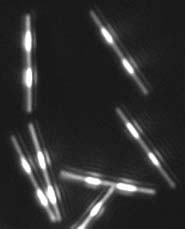Rods barcode reactions

Tiny rods could barcode molecules. <br>© Photodisc
Stripes help chemists shop for molecules.
Scientists may soon be sticking bar-coded metal rods into molecules to see what they do in a crowd1. The rods could help to track the functions and interactions of genes, and may aid drug discovery.
At only a few thousandths of a millimetre long, the rods are small enough to fit inside a single red blood cell. Christine Keating, of Pennsylvania State University, and colleagues cast them inside cylindrical pores in a thin film of aluminium oxide using an electrochemical process similar to gold-plating.
The group build up the bar codes by part-filling the pores with a succession of up to seven different metals, including gold, silver, platinum and copper, rather as children fill glass tubes with layers of differently coloured sand. They can give each rod up to 13 distinguishable stripes.
Using just two metals on a rod 6.5 micrometres long with bands of half a micrometre each, there are 4,160 possible combinations. With three metals, the number leaps to about 800,000. This is many more than the total number of genes in human cells, and so a different bar code could easily be assigned to every protein encoded by our genes.
The researchers read the barcodes using a special kind of electron microscopy. Gold bands, for example, appear brighter than silver. The bands are also visible, albeit more fuzzily, in a normal light-based (optical) microscope, which is easier to use and less damaging to living cells. With the right wavelength of light shining on the rod, at least five kinds of metal can be identified by their differing brightnesses.
As the rods are much larger than most molecules, using them as tags is a bit like sticking a price label on a grain of salt. That doesn’t matter as long as adding the label does not significantly alter the molecule’s behaviour. For example, chain-like molecules that bind to gold might be used as flexible linkers that grasp the ’test molecule’ at one end and a gold band on the rod at the other.
References
- Nicewarner-Pena, S. R. et al. Submicrometer metallic barcodes. Science, 294, 137 – 141, (2001).
Media Contact
More Information:
http://www.nature.com/nsu/011011/011011-2.htmlAll latest news from the category: Life Sciences and Chemistry
Articles and reports from the Life Sciences and chemistry area deal with applied and basic research into modern biology, chemistry and human medicine.
Valuable information can be found on a range of life sciences fields including bacteriology, biochemistry, bionics, bioinformatics, biophysics, biotechnology, genetics, geobotany, human biology, marine biology, microbiology, molecular biology, cellular biology, zoology, bioinorganic chemistry, microchemistry and environmental chemistry.
Newest articles

Silicon Carbide Innovation Alliance to drive industrial-scale semiconductor work
Known for its ability to withstand extreme environments and high voltages, silicon carbide (SiC) is a semiconducting material made up of silicon and carbon atoms arranged into crystals that is…

New SPECT/CT technique shows impressive biomarker identification
…offers increased access for prostate cancer patients. A novel SPECT/CT acquisition method can accurately detect radiopharmaceutical biodistribution in a convenient manner for prostate cancer patients, opening the door for more…

How 3D printers can give robots a soft touch
Soft skin coverings and touch sensors have emerged as a promising feature for robots that are both safer and more intuitive for human interaction, but they are expensive and difficult…





















